It’s a dying art but something many of us took for granted in our childhood – having a ‘cubby house’. If you’re children are pestering you for one – or if you’d just like to give them their own special place – Sunlite Mitre 10 has put together a DIY guide to help parents restore some old-fashioned playtime at home.
Step 1: Mark the site
Your children will spend hours playing in their new cubby. So pick a site in a slightly shaded position so it doesn’t become too hot for them in summer, and with enough ground around it to extend their play outdoors.
The first step after that is to accurately set out the cubby area.
Mark an area measuring 1800mm square by driving 8 sets of hurdles into the ground. These are made using timber setout pegs and scrap timber. These allow the stringline to be moved around when setting out (Fig. 1).
Lines 1 and 2 should be equal length, lines 3 and 4 equal length. Then measure the diagonally opposite corners, lines 5 and 6. Adjust the corner pegs if necessary until both these lines measure the same, but make certain that the measurement along lines 1, 2, 3 and 4 remain at exactly 1800mm to ensure the site is both parallel and square.
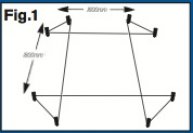
Step 2: Build Floor Frame
The foundation is the most critical stage of construction. Any errors here will affect all later work, so take your time and double check all measurements and setting out.
Dig corner stump holes 400mm deep x 300mm square. Dig them so that when the stumps are centred in them, their outside edges are flush with the string line. Place a timber sole plate in the bottom of each hole and stand a stump on it. Or use a 50mm layer of concrete instead of the timber sole plate.
When stump is in the correct position, fill the hole with concrete mix and water. While concrete firms, check that the stump is flush with line and plumb. Allow adequate time for concrete to harden.
Measure and mark 70mm up from the ground on the outside of the stump located at the highest point of ground level. Transfer this mark to all other stumps by using a 2100mm length of straight timber and a spirit level (Fig. 2). Mark all four sides of each post with a carpenter’s square, remove the posts and cut to the marked lengths.
Replace in their holes when cut to size.
Now cut two 100 x 100mm bearers to 1800mm long. Place them on top of the stumps, making sure the outside surface of each stump is flush with the end of the bearer and skew nail the bearer to each stump with two 75mm galvanised nails.
Cut five 90 x 45mm joists to 1800mm long. Skew nail a joist to each end of the bearers with two 75mm galvanised nails per fixing point. Set out the three other joists 394mm apart on the bearers and fix them to it in the same way. Finally, replace the soil in the stump holes and tamp down hard.
Complete the frame by cutting the sheet flooring in half so you have two 900mm wide x 1800mm long pieces. Lay one sheet on the joists with the plastic tongue in the centre and fix to each joist with galvanised 60mm flat head nails at 200mm spacings.
Remove the plastic tongue from the remaining piece, lay it on the frame and push it into the tongue of the sheet already fixed. Nail it to the joists as before.
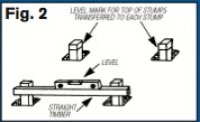
Step 3: Make Wall Frames
Start by cutting twenty 70 x 35mm studs, five each wall, to 1430mm long. By the time top and bottom plates are added, the walls will be 1500mm high.
Next, cut the top and bottom plates for the front and rear walls to 1800mm long and the end plates, which are located between them, to 1660mm long (Fig. 3). Lay the plates in pairs on the floor at the wall positions.
Mark the stud spacings using a carpenter’s square on each pair and code mark them for each wall.
Now, remove the plates in pairs to make the walls, the front wall first. Lay the plates the length of a stud apart. Place five studs in their approximate positions between the plates as marked. Nail the plates to each stud with two 75mm galvanised nails. Stand the wall frame up and temporarily brace it in position (Fig. 4). Nail the bottom plate at each corner with a 75mm galvanised nail and into the flooring at each floor joist.
Make a side wall frame in the same way and fix in position as before. Then connect the walls by nailing the corner studs together I50mm from the bottom and top and one in the centre. The rear wall and remaining side wall frames are made, positioned and fixed to the floor and each other using the same procedure.
Finally, check all corners are plumb and temporarily brace each wall from the inside to hold the structure plumb.
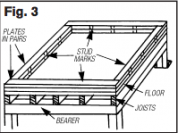
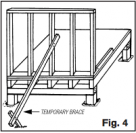
Step 4: Make Roof Frames
Cut six main rafters to 1155mm long which includes a 100mm overhang of the walls. Rafter ends are cut at an angle to the pitch of the roof. To ensure the correct angle, make a template first from a timber scrap as shown (Fig. 5).
Then set a sliding bevel to the angle and mark both ends of each rafter (Fig. 6). At the same time, mark the foot cut to the same angle. To make the frame, lay one pair of rafters on a flat level surface with the tops pressed firmly together and the foot cuts 1800mm apart (Fig. 6).
Nail the rafters together at the top with a gang nail plate. Turn the rafters over, check the foot cuts are 1800mm apart, and fix a gang nail plate on this side, too.
Make the two other frames in the same way. Lastly, cut four 70 x 35 x 847mm pieces of pine and nail two to each of the front and rear wall top plates (Fig. 7) for fixing the rafter frames and wall lining.
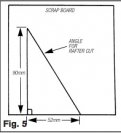
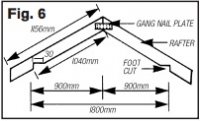
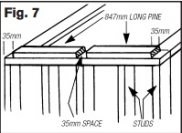
Step 5: Raise the Roof
You’ll need an extra pair of hands to help you here – one to hold the rafter frame in position while the other nails it. Place one of the end frames in position and skew nail to the plate on each side with one 75mm nail through the rafter foot cut into the plate, and one directly into the plate block. Do the same at the other end.
Then fix the middle frame by skew nailing through the foot cut with one nail each side. Now cut four 70 x 35mm roof battens to 1800mm long. Nail the top battens 100mm down from the ridge point on each side with two 75mm nails at each fixing point and the bottom battens 50mm up from the bottom of the rafters.
The roofing overhangs the bottom of the battens by 100mm. Fix it to the battens with roofing nails through the top of the corrugations and every third corrugation (Fig. 8).
Finish by nailing on the ridge capping.

Step 6: Complete Structure
With wall frames fixed and roof up, make the door and window frames from 90 x 19mm treated pine. Measure the openings, then cut and make the frames to suit. When installing, make sure they will be in line with the outer surface of the wall lining and nail to the studs with 50mm galvanised nails.
Step 7: Add Wall Lining
There’s an array of different exterior wall lining materials on the market today, including weatherboard, cement sheet, Weathertex building boards, exterior grade plywood, and others. The choice is yours and your Sunlite Mitre 10 store can help you choose and provide the necessary information and manufacturer’s fixing instructions.
Whichever you pick, the lining should extend 20mm below the bottom of the floor joists.
When the wall lining is on, cut the 90 x 19mm treated pine fascia boards. Cut them to the same length as the rafters with the same end cuts but not the foot cuts. Fit them to the gable ends over the wall lining with the top of the fascia board in line with the top of the roofing corrugations (Fig. 9).
Then nail a 70 x 19mm treated pine capping to the top of the fascia. Finish by fixing 42 x 19mm treated pine architrave over the outside of the door frame and lining boards for a neat and water-tight finish.
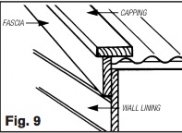
Step 8: The Final Touches
Adding the door and window means you’re nearly there. Measure the door frame opening, then cut the exterior grade plywood 4mm smaller than the opening. Fit the “T” hinges to the door 100mm from the top and bottom and fix the door to the door frame.
Check for operation and make any adjustments necessary before fitting a lock or latch. Treated pine fence palings can be fitted to the front of the plywood door to match the exterior.
For the window, we recommend installing Perspex rather than glass for safety, and weather sealing it with silicone. If painting architrave, seal it after as paint does not take to silicone.
Finally, add a protective stain or paint finish. If you prefer, the treated pine can be left to age naturally to an attractive finish. Your Sunlite Mitre 10 paint department will be able to show you a range of finishes and colours to complement the setting.
Step 8: The final touches
Adding the door and window means you’re nearly there.
Measure the door frame opening, then cut the exterior grade plywood 4mm smaller than the opening. Fit the “T” hinges to the door 100mm from the top and bottom and fix the door to the door frame. Check for operation and make any adjustments necessary before fitting a lock or latch.
Treated pine fence palings can be fitted to the front of the plywood door to match the exterior. For the window, we recommend installing Perspex (available to order) rather than glass for safety, and weather sealing it with silicone. If painting architrave, seal it after as paint does not take to silicone.
Finally, add a protective stain or paint finish. If you prefer, the treated pine can be left to age naturally to an attractive finish. The paint department of your local hardware store will be able to show you a range of finishes and colours to complement the setting.
Tools you need
- Power drill & bits
- Power saw or hand saw
- Measuring tape
- Pencil
- Spirit level
- String line
- Carpenter’s square
- Sliding bevel
- Hammer
- Spade
- Tin snips
Timber order
Wet sawn or kiln dried treated pine
- 4 Stumps – 100 x 100 x 700mm 1/3.0
- 4 Sole plates – 200 x 200 x 50mm 1/1.8
- 2 Bearers – 100 x 100 x 1800mm 2/1.8 or 1/3.6
- 5 Floor joists – 90 x 45mm 5/1800mm 2/3.6 1/1.8
- 4 Fascia boards – 90 x 19 x 1500mm 2/3.0
- Door frame – 90 x 19mm 1 x 600mm 2 x 1500mm 1/3.6
- Window frame x 2 – 90 x 19mm 450 x 450mm 2/1.8
- 4 Fascia capping – 70 x 19 x 1200mm 2/2.4
Standard Dressed Pine
- 4 Wall plates – 70 x 35 x 1800mm 2/3.6
- 4 Wall plates – 70 x 35 x 1660mm 2/3.6
- 20 Studs – 70 x 35 x 1430mm 10/3.0
- 4 Roof battens – 70 x 35 x 1800mm 2/3.6
- 4 Plate blocks – 70 x 35 x 847mm 2/1.8
- 6 Rafters – 90 x 35 x 1350mm 3/2.7
- Temporary bracing x 2 – 70 x 35 x 2400mm 2/2.4
Flooring
- Yellow or orange tongue floor sheet 3600 x 900mm 1/3.6 x 900
Door
- Exterior grade plywood x 1 – 1440 x 710mm 1/900 x 1800
Hardware
- 75mm galvanised bullet head nails
- 50mm galvanised bullet head nails
- 65mm galvanised flat head nails
- 60mm galvanised roofing nails
- 6 gang nail plates
- 1 pair 150mm “T” hinges and screws
- 1 – 2mm thick Perspex to suit window opening
- 5 sheets corrugated zincalume iron roofing I.I56mm
- 1 – zinc zincalume iron ridge capping I800mm
- 6 bags of pre-mixed concrete (1.5 bags per hole)
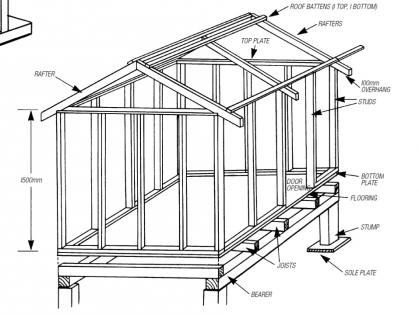





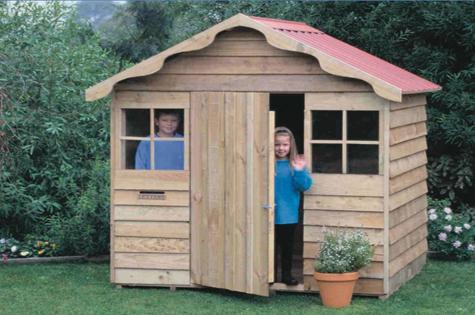











__small.png)










